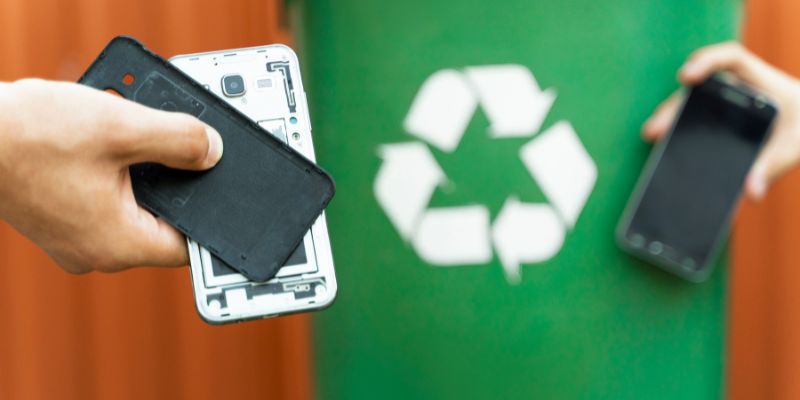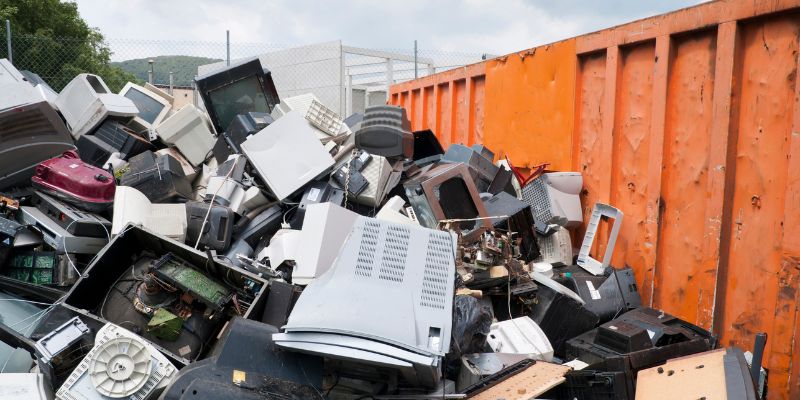The widespread adoption of electronic devices has transformed our lifestyles and workplaces. However, this advancement has also brought a critical environmental concern: electronic waste, or e-waste. E-waste encompasses a diverse range of discarded electronic devices, from smartphones and laptops to household appliances and industrial equipment. If not properly managed, these items present significant environmental and health risks.
The exponential growth of e-waste in recent years has become a global concern. Constant upgrades by consumers and regular technology refreshes by businesses have led to astonishing levels of electronic devices reaching their end-of-life. Sadly, much of this e-waste either ends up in landfills or experiences improper recycling, resulting in pollution, resource depletion, and health hazards for nearby communities. Addressing this challenge requires action from individuals, businesses, and policymakers. It’s crucial to embrace sustainable practices, such as reducing consumption, promoting reuse, and implementing responsible recycling methods, to mitigate the environmental impact of e-waste.

What Is the Meaning of E-Waste?
E-waste, short for electronic waste, refers to discarded electronic devices that have reached the end of their useful life. These devices contain various components, including metals, plastics, glass, and other materials, many of which can be hazardous to the environment if not properly managed. E-waste includes a wide range of electronic devices, such as smartphones, laptops, desktop computers, televisions, refrigerators, and other household appliances, as well as industrial equipment.
The components of e-waste can vary depending on the type of electronic device. For example, smartphones and laptops typically contain batteries, circuit boards, screens, and casing materials, while larger appliances like refrigerators and washing machines may contain additional components such as compressors and wiring.
The expansion of electronic devices has led to a significant increase in e-waste generation. The amount of e-waste generated worldwide is growing exponentially, with millions of tons being discarded each year. This is driven by factors such as technological advancements, shorter product lifecycles, and increased consumer demand for the latest gadgets and appliances.
As the volume of e-waste continues to rise, it is important to address this environmental challenge through responsible recycling and disposal practices. By understanding the meaning of e-waste and its components, we can better appreciate the importance of adopting sustainable solutions to minimize its impact on the environment and human health.
Why Is E-Waste a Problem?
E-waste poses a significant problem because of its adverse environmental, health, and economic impacts.
Environmental Impact: Improper disposal of e-waste can lead to severe environmental degradation. Electronic devices contain hazardous materials such as lead, mercury, cadmium, and brominated flame retardants, which can contaminate soil and water if not handled properly. When e-waste is dumped in landfills or incinerated, these toxic substances can drain into the surrounding environment, polluting groundwater and harming ecosystems. The incineration of e-waste also releases greenhouse gases and other pollutants into the atmosphere, contributing to air pollution and climate change.
Health Hazards: Exposure to e-waste can mean significant health risks to both humans and wildlife. Workers involved in informal e-waste recycling operations, often in developing countries, are particularly vulnerable to chemical exposure and physical injuries. Inhalation of toxic fumes from burning e-waste can cause respiratory problems, while direct contact with hazardous substances can lead to skin irritations, neurological disorders, and even cancer. The improper dismantling and disposal of electronic devices can also result in the release of heavy metals and other pollutants into the environment, posing long-term health risks to nearby communities.
Economic Implications: Inefficient management of e-waste represents a missed opportunity for resource recovery and economic growth. Electronic devices contain valuable materials such as gold, silver, copper, and rare earth elements, which can be recycled and reused in the manufacturing of new products. However, when e-waste is discarded or improperly recycled, these valuable resources are lost, leading to resource depletion and increased demand for virgin materials. Moreover, the lack of proper e-waste management infrastructure can result in economic losses due to the high costs associated with environmental cleanup, healthcare expenses, and lost productivity.

R2v3 Certification: Promoting Sustainable E-Waste Management
R2v3 certification, short for Responsible Recycling version 3, is a crucial standard in e-waste management, aiming to ensure responsible handling and disposal of electronic waste.
R2v3 certification is developed and maintained by SERI (Sustainable Electronics Recycling International), offering comprehensive guidelines for electronics recyclers. These guidelines encompass environmental stewardship, data security, and worker health and safety.
Certified recyclers under the R2v3 standard are required to meet strict requirements. These include implementing documented procedures for the proper handling, storage, and disposal of electronic devices, as well as establishing measures to prevent the release of hazardous substances into the environment. Additionally, R2v3 certified recyclers undergo regular audits and assessments to maintain compliance with the standard.
The advantages of choosing R2v3 certified recyclers are various. Firstly, it ensures environmental responsibility by promoting safe and sustainable disposal of electronic waste, minimizing its impact on ecosystems and communities. Secondly, R2v3 certification includes strict protocols for data security, guaranteeing the secure erasure or destruction of sensitive information stored on electronic devices. This is particularly crucial today, where data breaches and identity theft pose significant risks. Furthermore, R2v3 certification demonstrates a commitment to compliance with relevant regulations and industry best practices, providing assurance to stakeholders and customers.
In summary, R2v3 certification serves as a benchmark of quality in e-waste recycling, indicating a commitment to sustainability, data security, and regulatory compliance. By partnering with R2v3 certified recyclers, businesses can contribute to a cleaner environment, protect sensitive information, and uphold ethical standards in the management of electronic waste.
Avoiding E-Waste with R2v3 Certified Processes
Partnering with R2v3 certified, compliant companies for e-waste management is essential in mitigating the environmental impact and ensuring secure handling of electronic devices.
R2v3 certification serves as a benchmark of quality and excellence in e-waste recycling. By choosing R2v3 certified recyclers, businesses can trust that their electronic waste will be managed responsibly, adhering to strict environmental, data security, and worker safety standards. This ensures that e-waste is handled in a manner that minimizes its impact on the environment and reduces the risk of data breaches or exposure to hazardous materials.
The Department of Defense Information Security Technology (DOD IST) process aligns with R2v3 standards for secure data erasure. This process involves comprehensive procedures for the sanitization of electronic devices to ensure that sensitive data is securely erased before disposal or recycling. By following the DOD IST process, R2v3 certified recyclers guarantee that all data stored on electronic devices is removed, preventing unauthorized access or data breaches. This not only safeguards sensitive information but also ensures compliance with data protection regulations and industry best practices.
Best Practices for E-Waste Recycling
Responsible e-waste disposal and recycling are essential for mitigating environmental impact and promoting sustainability. Here are some best practices for consumers and businesses:
Proper Disposal and Recycling: Ensure that electronic devices are disposed of and recycled through certified e-waste recycling facilities. Avoid dumping e-waste in landfills or incinerating it, as this can lead to environmental pollution and health hazards. Look for e-waste recycling programs or drop-off locations in your area to safely recycle old electronics.
Collection and Transportation: Implement efficient collection and transportation systems for e-waste to ensure it reaches recycling facilities without causing harm to the environment. Consider organizing e-waste collection events or partnering with e-waste recycling companies to facilitate the proper disposal of electronic devices.
Extending Lifespan of Electronics: Encourage the repair, refurbishment, and donation of electronic devices to extend their lifespan and reduce e-waste generation. Support initiatives that promote the repairability of electronics and provide resources for repairing or upgrading devices instead of replacing them unnecessarily.
Education and Awareness: Educate consumers and businesses about the importance of proper e-waste disposal and recycling. Raise awareness about the environmental and health impacts of improper e-waste management and the benefits of adopting sustainable practices.
Legislation and Regulation: Advocate for stronger legislation and regulation to promote responsible e-waste management. Support initiatives that require manufacturers to take responsibility for the end-of-life disposal of their products and incentivize the recycling and reuse of electronic devices.
By following these best practices, consumers and businesses can contribute to reducing the environmental footprint of electronic devices and promoting a circular economy for e-waste recycling. Together, we can work towards a more sustainable future by responsibly managing electronic waste and minimizing its impact on the environment and human health.

Conclusion
The issue of e-waste presents a pressing challenge that demands our immediate attention. As our reliance on electronic devices continues to grow, so too does the urgency of addressing the environmental, health, and economic impacts associated with their disposal.
It’s essential that businesses and individuals prioritize sustainable e-waste management practices. By responsibly disposing of electronic devices and recycling them through certified facilities, we can minimize the environmental footprint of e-waste and reduce its harmful effects on our planet and communities.
As we move forward, let us recognize the collective responsibility we share in creating a more sustainable and environmentally friendly future. By working together to promote responsible recycling solutions and adopting initiatives like R2v3 certification, we can make a meaningful impact on e-waste management.
At ReluTech, we are committed to leading by example. As an R2v3 certified company, we adhere to the highest standards of e-waste recycling and disposal. We prioritize environmental stewardship, data security, and worker safety in all our operations. Check out our IT Asset Disposition offerings to learn more about our services and how we can help you responsibly manage your electronic waste.